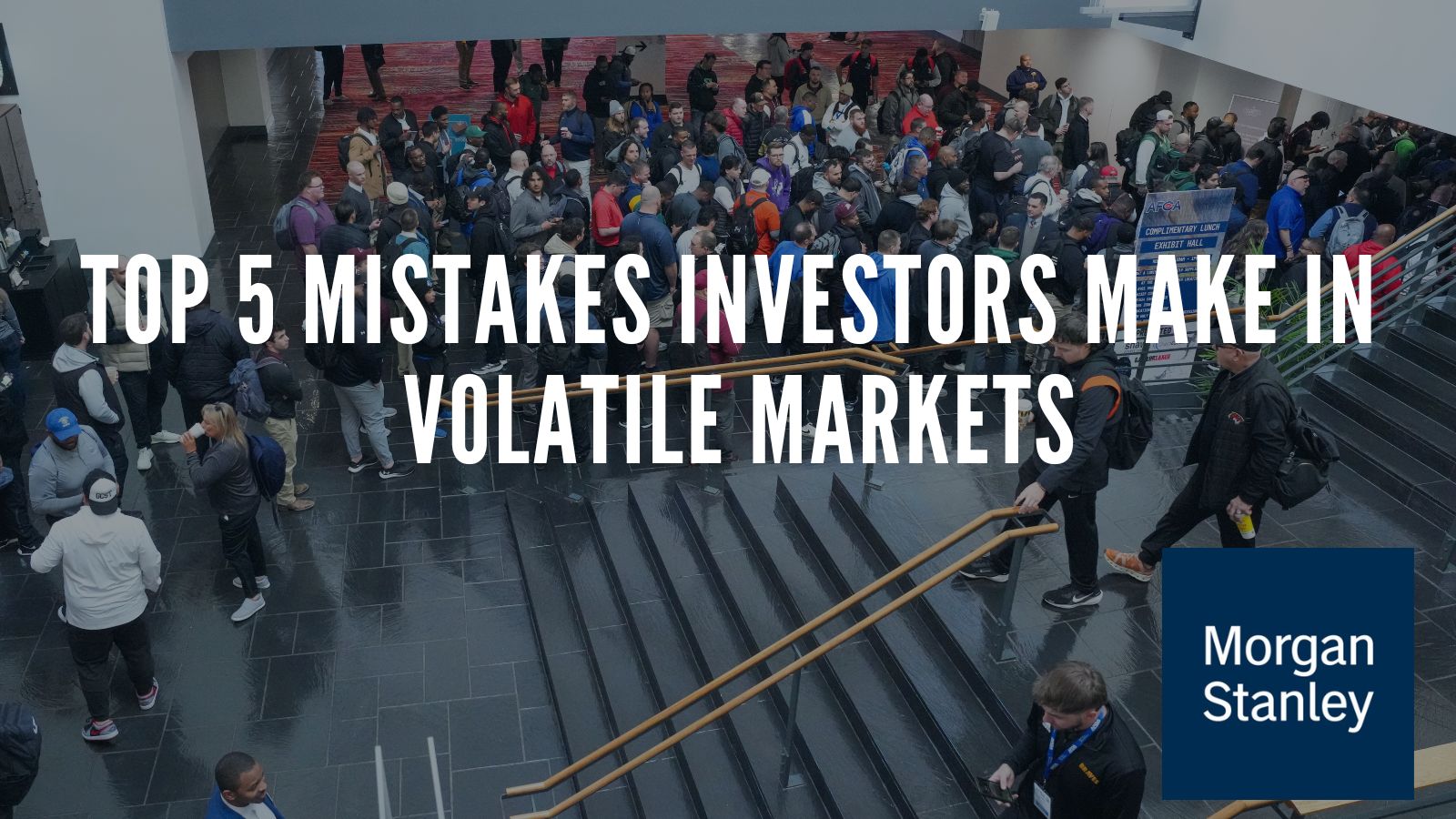
Top 5 Mistakes Investors Make in Volatile Markets
May 13, 2025
Whether it is panic selling, hiding out in cash or trading frantically during volatile markets, investors tend to make several mistakes that can hurt them long-term. Know how to spot—and avoid—the most common bad behaviors.
These are some of the top mistakes investors typically make and our suggestions for what to do instead:
- 1. They panic-sell.
It can be gut-wrenching to see your investment portfolio or the 401(k) plan that you’ve been building for years take a sudden dive. The urge to staunch the bleeding can be overwhelming–to salvage what you can and wait for the dust to settle. Ironically, this can be the single most damaging thing an investor can do.
Selling into a falling market ensures that you lock in your losses. If you wait years to get back in, you may never recover. Consider that someone who stayed invested from 1980 until the end of February 2025 would have a 12% annual return, whereas someone who started at the same time, but sold after market downturns and stayed out of the market until two consecutive years of positive returns, would have averaged a 10% return annually.
That may not sound like a huge difference, but if each investor contributed $5,000 a year, the buy-and-hold investor would have $6.1 million now; the waffler would have $3.6 million.
Instead, consider this: Take the long view. If you don’t need cash right away and have a well-researched, diversified portfolio, realize that downturns ultimately are temporary. The market may sometimes feel like it could go to zero, but market history shows that rebounds can return many portfolios to the black in just a few years.
- 2. They go to cash and stay there.
This mistake compounds the damage from panic selling. The strong rebound in stock prices that often follows a market downturn should underscore how bailing out can cost you when the market reverses direction. Returning to our hypothetical example, an investor who sold after a 30% market drop and stayed in cash would have just $524,000 after more than 45 years, even after investing $5,000 a year.
Instead, consider this: Investors who have more cash than their long-term strategy calls for because they sold during the market slide, or for any other reason, should look to close that gap and get invested. Dollar-cost averaging, a method where you buy set amounts of stock at regular intervals (say, monthly) to get back into the market gradually, can be a good way to get there. Dollar-cost averaging reduces the sensitivity of your portfolio to the luck of timing, which can make it easier for fearful investors to move out of cash, since they can avoid the worry of putting a big chunk of money into the market, only to have the sell-off resume. And if the market rebounds, they will be glad that they already put some of their money back to work, rather than having all of it on the sidelines.
- 3. They are overconfident and make poor choices.
Many people overestimate their ability to judge when a stock is a great deal at a certain price. An example of that is “anchoring” the value of a beaten down company by the much higher price it used to trade at when it still has a lot further to fall. As this practice is known by market insiders as “trying to catch a falling knife,” it is clearly one with an ignominious history.
Overconfident investors tend to think they know better than even professional investors what’s going on in markets and can make all the right moves to avoid losses and lock in bargains. They can drive themselves to distraction and end up with a portfolio in disarray and even deeper losses. Profiting from short-term trading is a lot more difficult in practice than it seems.
Instead, consider this: In times of market uncertainty, you don’t have to figure out what to do next on your own. Find a Financial Advisor you are comfortable with to go through your portfolio with you and help you understand how to proceed, based on your time horizon and risk tolerance.
- 4. They dig a deeper hole trying to make up for losses or bad choices.
It is common for investors to loathe the idea of selling an investment at a loss, or below the high water mark. This can cause them to hang onto losers too long because they believe those stocks will rise again and to sell winners too early because they worry those stocks will decline—what is known in behavioral finance research as the “disposition effect.” Often, investors would be better off selling stocks doing poorly in the market and holding onto stocks that are rising because they are better positioned for the current environment.
Instead, consider this: Proactively take advantage of current opportunities, which can often run counter to those instincts. For example, if losses arise in a taxable investment account, “harvesting” them by selling those positions can improve long-term tax efficiency. Also, many investors are better off converting at least some of their retirement savings from a traditional IRA to a Roth IRA. Since there are tax consequences, doing a conversion when stock values are depressed could be a good move. This, again, is something a Financial Advisor can help with.
- 5. They forget to rebalance.
During a major market selloff, a portfolio’s asset allocation to equities tends to decrease substantially, as stocks sell off and bonds rally. Often shocked by the move, investors may neglect to rebalance their portfolios back into equities and, as a result, may extend the amount of time the portfolio takes to recover from a market drawdown.
Instead, consider this: If you’ve decided on a rebalancing plan, stick to it. Studies have shown that rebalancing tends to improve risk-adjusted returns over time, as long as it doesn’t generate excessive tax and transaction costs, by reducing portfolio sensitivity to the timing of up and down markets. It also gels with markets’ natural tendency to revert to the mean.
The corollary to buying equities to rebalance after a selloff is the need to sell them after a strong bull market moves those allocations much higher. That tends to enforce a buy-low and sell-high discipline on your investments that is systematic, rather than speculative.
Another Mistake: Not Basing Your Decisions on a Financial Plan
Each of these five mistakes have one thing in common: They involve investors reacting to market events. But being reactive can be costly. As an example, take the 2020 COVID market crash, in which the S&P 500 Index fell by 34% in just over a month. If you sold along with the crowd, it’s likely that your portfolio would have been severely impaired.
Instead do this: Work with your Financial Advisor to create a thoughtful financial plan that can serve as your “north star,” helping you to avoid rash decisions in times of market stress and to focus on what really matters: staying on track toward your long-term goals.
Our study of nearly 120,000 investors with a Morgan Stanley financial plan during the COVID crash found that more than three-quarters of those who were considered “on track” to achieve their goals at the market’s peak remained on track even at the market’s bottom—before equities began their subsequent recovery.1 In addition, despite a portfolio decline of 16% for the typical investor in this group, their likelihood of achieving their financial goals was down just 2% at the market’s trough.
What’s more, if you were at risk of falling off track, small changes to your financial plan—such as modestly increasing your savings rate, slightly reducing your spending and/or waiting a little longer for your goal—likely would have helped you get back on track, without resorting to selling assets in a down market.*
There’s no question that investment losses are painful, but if investors can stay focused on their goals, rather than obsessing over monthly account statements, they will likely feel better and be better off in the long run. Working with your Financial Advisor can help you steer through volatility and stick with your plan.
About the Authors
Keith Norris, Senior Vice President and Financial Advisor, and Matt Kuerzi, Senior Vice President and Financial Advisor, are co-founders of The Derby City Group at Morgan Stanley in Louisville, Kentucky. They have combined over 45 years of experience helping families with their financial planning*. The Derby City Group at Morgan Stanley has been recognized by Forbes in the Forbes “Best-In-State Wealth Management Teams” ranking in 2025. Similarly, Matt was recognized by Forbes in their first ever list of “Best-In-State Next-Gen Advisors” in 2019 and more recently as a “Best-In-State Wealth Advisor” in 2023, 2024, and 2025. He can be reached directly at (502) 394-4094 or [email protected].
Forbes Best-In-State Wealth Management Teams (2025)
Source: Forbes.com (January 2025) 2025 Forbes Best-In-State Wealth Management Teams ranking awarded in 2024. This ranking was determined based on an evaluation process conducted by SHOOK Research LLC (the research company) in partnership with Forbes (the publisher) for the period from 3/31/23-3/31/24. Neither Moran Stanley Smith Barney LLC nor its Financial Advisors or Private Wealth Advisors paid a fee to SHOOK Research LLC, for placement on its rankings. This ranking is based on in-person and telephone due diligence meetings to evaluate each Financial Advisor qualitatively, a major component of a ranking algorithm that includes client retention, industry experience, review of compliance records, firm nominations, and quantitative criteria, including assets under management and revenue generated for their firms. Investment performance is not a criterion. Rankings are based on the opinions of SHOOK Research LLC and may not be representative of any one client’s experience; investors must carefully choose the right Financial Advisor or team for their own situation and perform their own due diligence. This ranking is not indicative of the Financial Advisor’s future performance. Morgan Stanley Smith Barney LLC is not affiliated with SHOOK Research LLC or Forbes. For more information, see www.SHOOKreserach.com.
Forbes Top Next-Gen Wealth Advisors (2019)
Source: Forbes.com (June 2019) 2019 Forbes Top Next-Gen Wealth Advisors ranking awarded in 2019. This ranking was determined based on an evaluation process conducted by SHOOK Research LLC (the research company) in partnership with Forbes (the publisher) for the period from 3/31/18 – 3/31/19. Neither Moran Stanley Smith Barney LLC nor its Financial Advisors or Private Wealth Advisors paid a fee to SHOOK Research LLC, for placement on its rankings. This ranking is based on in-person and telephone due diligence meetings to evaluate each Financial Advisor qualitatively, a major component of a ranking algorithm that includes client retention, industry experience, review of compliance records, firm nominations, and quantitative criteria, including assets under management and revenue generated for their firms. Investment performance is not a criterion. Rankings are based on the opinions of SHOOK Research LLC and may not be representative of any one client’s experience; investors must carefully choose the right Financial Advisor or team for their own situation and perform their own due diligence. This ranking is not indicative of the Financial Advisor’s future performance. Morgan Stanley Smith Barney LLC is not affiliated with SHOOK Research LLC or Forbes. For more information, see www.SHOOKreserach.com.
Forbes Best-In-State Wealth Advisors (2023, 2024, and 2025)
Source: Forbes.com (2023, 2024, and 2025) Forbes Best-In-State Wealth Advisors ranking awarded in 2023, 2024, and 2025. Each ranking was based on an evaluation process conducted by SHOOK Research LLC (the research company) in partnership with Forbes (the publisher). This evaluation process concluded in June of the previous year the aware was issued having commenced in June of the year before that. Neither Morgan Stanley Smith Barney LLC nor its Financial Advisors or Private Wealth Advisors paid a fee to SHOOK Research LLC, for placement on its rankings. This ranking is based on in-person and telephone due diligence meetings to evaluate each advisor qualitatively, a major component of a ranking algorithm that includes client retention, industry experience, review of compliance records, firm nominations, and quantitative criteria, including assets under management and revenue generated for their firms. Investment performance is not a criterion. Rankings are based on the opinions of SHOOK Research LLC and this ranking may not be representative of any one client’s experience. These rankings are not indicative of the Financial Advisor’s future performance. Morgan Stanley Smith Barney LLC is not affiliated with SHOOK Research LLC or Forbes. For more information, see www.SHOOKreserach.com. @ 2025 Morgan Stanley Smith Barney LLC. Member SIPC.
Branch address: 4969 U.S. Highway 42, Suite 1200, Louisville, KY 40222
*Keith Norris, Senior Vice President, Financial Advisor, experienced in the financial services industry since 1997. Matt Kuerzi, Senior Vice President, Financial Advisor, experienced in the financial services industry since 2002.
Footnotes
(*) Source: “Plan Not to Panic: Navigating Market Volatility with Financial Planning,” Morgan Stanley Wealth Management Global Investment Office, April 16, 2024.
Risk Considerations
Yields are subject to change with economic conditions. Yield is only one factor that should be considered when making an investment decision.
Equity securities may fluctuate in response to news on companies, industries, market conditions and general economic environment.
Bonds are subject to interest rate risk. When interest rates rise, bond prices fall; generally the longer a bond’s maturity, the more sensitive it is to this risk. Bonds may also be subject to call risk, which is the risk that the issuer will redeem the debt at its option, fully or partially, before the scheduled maturity date. The market value of debt instruments may fluctuate, and proceeds from sales prior to maturity may be more or less than the amount originally invested or the maturity value due to changes in market conditions or changes in the credit quality of the issuer. Bonds are subject to the credit risk of the issuer. This is the risk that the issuer might be unable to make interest and/or principal payments on a timely basis. Bonds are also subject to reinvestment risk, which is the risk that principal and/or interest payments from a given investment may be reinvested at a lower interest rate.
Asset allocation and diversification do not assure a profit or protect against loss in declining financial markets.
Rebalancing does not protect against a loss in declining financial markets. There may be a potential tax implication with a rebalancing strategy. Investors should consult with their tax advisor before implementing such a strategy.
Because of their narrow focus, sector investments tend to be more volatile than investments that diversify across many sectors and companies. Technology stocks may be especially volatile.
International investing entails greater risk, as well as greater potential rewards compared to U.S. investing. These risks include political and economic uncertainties of foreign countries as well as the risk of currency fluctuations. These risks are magnified in countries with emerging markets, since these countries may have relatively unstable governments and less established markets and economies.
Investing in foreign emerging markets entails greater risks than those normally associated with domestic markets, such as political, currency, economic and market risks.
Investing in commodities entails significant risks. Commodity prices may be affected by a variety of factors at any time, including but not limited to, (i) changes in supply and demand relationships, (ii) governmental programs and policies, (iii) national and international political and economic events, war and terrorist events, (iv) changes in interest and exchange rates, (v) trading activities in commodities and related contracts, (vi) pestilence, technological change and weather, and (vii) the price volatility of a commodity. In addition, the commodities markets are subject to temporary distortions or other disruptions due to various factors, including lack of liquidity, participation of speculators and government intervention.
Certain securities referred to in this material may not have been registered under the U.S. Securities Act of 1933, as amended, and, if not, may not be offered or sold absent an exemption therefrom. Recipients are required to comply with any legal or contractual restrictions on their purchase, holding, and sale, exercise of rights or performance of obligations under any securities/instruments transaction.
Indices are unmanaged. An investor cannot invest directly in an index.
For index, indicator and survey definitions referenced in this report please visit the following:
https://www.morganstatnley.com/wealth-investmentsolutions/wmir-definitions
This illustration is hypothetical and shown for illustrative purposes only. The illustration is not intended to predict the returns or any particular investment, which will fluctuate with market conditions. Actual results may differ from those depicted in the illustration.
Disclosures
Morgan Stanley Wealth Management is the trade name of Morgan Stanley Smith Barney LLC, a registered broker-dealer in the United States. This material has been prepared for informational purposes only and is not an offer to buy or sell or a solicitation of any offer to buy or sell any security or other financial instrument or to participate in any trading strategy. Past performance is not necessarily a guide to future performance.
The author(s) (if any authors are noted) principally responsible for the preparation of this material receive compensation based upon various factors, including quality and accuracy of their work, firm revenues (including trading and capital markets revenues), client feedback and competitive factors. Morgan Stanley Wealth Management is involved in many businesses that may relate to companies, securities or instruments mentioned in this material.
This material has been prepared for informational purposes only and is not an offer to buy or sell or a solicitation of any offer to buy or sell any security/instrument, or to participate in any trading strategy. Any such offer would be made only after a prospective investor had completed its own independent investigation of the securities, instruments or transactions, and received all information it required to make its own investment decision, including, where applicable, a review of any offering circular or memorandum describing such security or instrument. That information would contain material information not contained herein and to which prospective participants are referred. This material is based on public information as of the specified date, and may be stale thereafter. We have no obligation to tell you when information herein may change. We make no representation or warranty with respect to the accuracy or completeness of this material. Morgan Stanley Wealth Management has no obligation to provide updated information on the securities/instruments mentioned herein.
The securities/instruments discussed in this material may not be suitable for all investors. The appropriateness of a particular investment or strategy will depend on an investor’s individual circumstances and objectives. Morgan Stanley Wealth Management recommends that investors independently evaluate specific investments and strategies, and encourages investors to seek the advice of a financial advisor. The value of and income from investments may vary because of changes in interest rates, foreign exchange rates, default rates, prepayment rates, securities/instruments prices, market indexes, operational or financial conditions of companies and other issuers or other factors. Estimates of future performance are based on assumptions that may not be realized. Actual events may differ from those assumed and changes to any assumptions may have a material impact on any projections or estimates. Other events not taken into account may occur and may significantly affect the projections or estimates. Certain assumptions may have been made for modeling purposes only to simplify the presentation and/or calculation of any projections or estimates, and Morgan Stanley Wealth Management does not represent that any such assumptions will reflect actual future events. Accordingly, there can be no assurance that estimated returns or projections will be realized or that actual returns or performance results will not materially differ from those estimated herein.
This material should not be viewed as advice or recommendations with respect to asset allocation or any particular investment. This information is not intended to, and should not, form a primary basis for any investment decisions that you may make. Morgan Stanley Wealth Management is not acting as a fiduciary under either the Employee Retirement Income Security Act of 1974, as amended or under section 4975 of the Internal Revenue Code of 1986 as amended in providing this material except as otherwise provided in writing by Morgan Stanley and/or as described at www.morganstanley.com/disclosures/dol.
Morgan Stanley Smith Barney LLC, its affiliates and Morgan Stanley Financial Advisors do not provide legal or tax advice. Each client should always consult his/her personal tax and/or legal advisor for information concerning his/her individual situation and to learn about any potential tax or other implications that may result from acting on a particular recommendation.
This material is disseminated in Australia to “retail clients” within the meaning of the Australian Corporations Act by Morgan Stanley Wealth Management Australia Pty Ltd (A.B.N. 19 009 145 555, holder of Australian financial services license No. 240813).
Morgan Stanley Wealth Management is not incorporated under the People’s Republic of China (“PRC”) law and the material in relation to this report is conducted outside the PRC. This report will be distributed only upon request of a specific recipient. This report does not constitute an offer to sell or the solicitation of an offer to buy any securities in the PRC. PRC investors must have the relevant qualifications to invest in such securities and must be responsible for obtaining all relevant approvals, licenses, verifications and or registrations from PRC’s relevant governmental authorities.
If your financial adviser is based in Australia, Switzerland or the United Kingdom, then please be aware that this report is being distributed by the Morgan Stanley entity where your financial adviser is located, as follows: Australia: Morgan Stanley Wealth Management Australia Pty Ltd (ABN 19 009 145 555, AFSL No. 240813); Switzerland: Morgan Stanley (Switzerland) AG regulated by the Swiss Financial Market Supervisory Authority; or United Kingdom: Morgan Stanley Private Wealth Management Ltd, authorized and regulated by the Financial Conduct Authority, approves for the purposes of section 21 of the Financial Services and Markets Act 2000 this material for distribution in the United Kingdom.
Morgan Stanley Wealth Management is not acting as a municipal advisor to any municipal entity or obligated person within the meaning of Section 15B of the Securities Exchange Act (the “Municipal Advisor Rule”) and the opinions or views contained herein are not intended to be, and do not constitute, advice within the meaning of the Municipal Advisor Rule.
This material is disseminated in the United States of America by Morgan Stanley Smith Barney LLC.
Third-party data providers make no warranties or representations of any kind relating to the accuracy, completeness, or timeliness of the data they provide and shall not have liability for any damages of any kind relating to such data.
This material, or any portion thereof, may not be reprinted, sold or redistributed without the written consent of Morgan Stanley Smith Barney LLC.
© 2025 Morgan Stanley Smith Barney LLC, Member SIPC.
CRC 4452010 4/2025
For more information about the AFCA, visit www.AFCA.com. For more interesting articles, check out The Insider and subscribe to our weekly email.
If you are interested in more in-depth articles and videos, please become an AFCA member. You can find out more information about membership and specific member benefits on the AFCA Membership Overview page. If you are ready to join, please fill out the AFCA Membership Application.
« « Previous PostNext Post » »
Whether it is panic selling, hiding out in cash or trading frantically during volatile markets, investors tend to make several mistakes that can hurt them long-term. Know how to spot—and avoid—the most common bad behaviors.
These are some of the top mistakes investors typically make and our suggestions for what to do instead:
- 1. They panic-sell.
It can be gut-wrenching to see your investment portfolio or the 401(k) plan that you’ve been building for years take a sudden dive. The urge to staunch the bleeding can be overwhelming–to salvage what you can and wait for the dust to settle. Ironically, this can be the single most damaging thing an investor can do.
Selling into a falling market ensures that you lock in your losses. If you wait years to get back in, you may never recover. Consider that someone who stayed invested from 1980 until the end of February 2025 would have a 12% annual return, whereas someone who started at the same time, but sold after market downturns and stayed out of the market until two consecutive years of positive returns, would have averaged a 10% return annually.
That may not sound like a huge difference, but if each investor contributed $5,000 a year, the buy-and-hold investor would have $6.1 million now; the waffler would have $3.6 million.
Instead, consider this: Take the long view. If you don’t need cash right away and have a well-researched, diversified portfolio, realize that downturns ultimately are temporary. The market may sometimes feel like it could go to zero, but market history shows that rebounds can return many portfolios to the black in just a few years.
- 2. They go to cash and stay there.
This mistake compounds the damage from panic selling. The strong rebound in stock prices that often follows a market downturn should underscore how bailing out can cost you when the market reverses direction. Returning to our hypothetical example, an investor who sold after a 30% market drop and stayed in cash would have just $524,000 after more than 45 years, even after investing $5,000 a year.
Instead, consider this: Investors who have more cash than their long-term strategy calls for because they sold during the market slide, or for any other reason, should look to close that gap and get invested. Dollar-cost averaging, a method where you buy set amounts of stock at regular intervals (say, monthly) to get back into the market gradually, can be a good way to get there. Dollar-cost averaging reduces the sensitivity of your portfolio to the luck of timing, which can make it easier for fearful investors to move out of cash, since they can avoid the worry of putting a big chunk of money into the market, only to have the sell-off resume. And if the market rebounds, they will be glad that they already put some of their money back to work, rather than having all of it on the sidelines.
- 3. They are overconfident and make poor choices.
Many people overestimate their ability to judge when a stock is a great deal at a certain price. An example of that is “anchoring” the value of a beaten down company by the much higher price it used to trade at when it still has a lot further to fall. As this practice is known by market insiders as “trying to catch a falling knife,” it is clearly one with an ignominious history.
Overconfident investors tend to think they know better than even professional investors what’s going on in markets and can make all the right moves to avoid losses and lock in bargains. They can drive themselves to distraction and end up with a portfolio in disarray and even deeper losses. Profiting from short-term trading is a lot more difficult in practice than it seems.
Instead, consider this: In times of market uncertainty, you don’t have to figure out what to do next on your own. Find a Financial Advisor you are comfortable with to go through your portfolio with you and help you understand how to proceed, based on your time horizon and risk tolerance.
- 4. They dig a deeper hole trying to make up for losses or bad choices.
It is common for investors to loathe the idea of selling an investment at a loss, or below the high water mark. This can cause them to hang onto losers too long because they believe those stocks will rise again and to sell winners too early because they worry those stocks will decline—what is known in behavioral finance research as the “disposition effect.” Often, investors would be better off selling stocks doing poorly in the market and holding onto stocks that are rising because they are better positioned for the current environment.
Instead, consider this: Proactively take advantage of current opportunities, which can often run counter to those instincts. For example, if losses arise in a taxable investment account, “harvesting” them by selling those positions can improve long-term tax efficiency. Also, many investors are better off converting at least some of their retirement savings from a traditional IRA to a Roth IRA. Since there are tax consequences, doing a conversion when stock values are depressed could be a good move. This, again, is something a Financial Advisor can help with.
- 5. They forget to rebalance.
During a major market selloff, a portfolio’s asset allocation to equities tends to decrease substantially, as stocks sell off and bonds rally. Often shocked by the move, investors may neglect to rebalance their portfolios back into equities and, as a result, may extend the amount of time the portfolio takes to recover from a market drawdown.
Instead, consider this: If you’ve decided on a rebalancing plan, stick to it. Studies have shown that rebalancing tends to improve risk-adjusted returns over time, as long as it doesn’t generate excessive tax and transaction costs, by reducing portfolio sensitivity to the timing of up and down markets. It also gels with markets’ natural tendency to revert to the mean.
The corollary to buying equities to rebalance after a selloff is the need to sell them after a strong bull market moves those allocations much higher. That tends to enforce a buy-low and sell-high discipline on your investments that is systematic, rather than speculative.
Another Mistake: Not Basing Your Decisions on a Financial Plan
Each of these five mistakes have one thing in common: They involve investors reacting to market events. But being reactive can be costly. As an example, take the 2020 COVID market crash, in which the S&P 500 Index fell by 34% in just over a month. If you sold along with the crowd, it’s likely that your portfolio would have been severely impaired.
Instead do this: Work with your Financial Advisor to create a thoughtful financial plan that can serve as your “north star,” helping you to avoid rash decisions in times of market stress and to focus on what really matters: staying on track toward your long-term goals.
Our study of nearly 120,000 investors with a Morgan Stanley financial plan during the COVID crash found that more than three-quarters of those who were considered “on track” to achieve their goals at the market’s peak remained on track even at the market’s bottom—before equities began their subsequent recovery.1 In addition, despite a portfolio decline of 16% for the typical investor in this group, their likelihood of achieving their financial goals was down just 2% at the market’s trough.
What’s more, if you were at risk of falling off track, small changes to your financial plan—such as modestly increasing your savings rate, slightly reducing your spending and/or waiting a little longer for your goal—likely would have helped you get back on track, without resorting to selling assets in a down market.*
There’s no question that investment losses are painful, but if investors can stay focused on their goals, rather than obsessing over monthly account statements, they will likely feel better and be better off in the long run. Working with your Financial Advisor can help you steer through volatility and stick with your plan.
About the Authors
Keith Norris, Senior Vice President and Financial Advisor, and Matt Kuerzi, Senior Vice President and Financial Advisor, are co-founders of The Derby City Group at Morgan Stanley in Louisville, Kentucky. They have combined over 45 years of experience helping families with their financial planning*. The Derby City Group at Morgan Stanley has been recognized by Forbes in the Forbes “Best-In-State Wealth Management Teams” ranking in 2025. Similarly, Matt was recognized by Forbes in their first ever list of “Best-In-State Next-Gen Advisors” in 2019 and more recently as a “Best-In-State Wealth Advisor” in 2023, 2024, and 2025. He can be reached directly at (502) 394-4094 or [email protected].
Forbes Best-In-State Wealth Management Teams (2025)
Source: Forbes.com (January 2025) 2025 Forbes Best-In-State Wealth Management Teams ranking awarded in 2024. This ranking was determined based on an evaluation process conducted by SHOOK Research LLC (the research company) in partnership with Forbes (the publisher) for the period from 3/31/23-3/31/24. Neither Moran Stanley Smith Barney LLC nor its Financial Advisors or Private Wealth Advisors paid a fee to SHOOK Research LLC, for placement on its rankings. This ranking is based on in-person and telephone due diligence meetings to evaluate each Financial Advisor qualitatively, a major component of a ranking algorithm that includes client retention, industry experience, review of compliance records, firm nominations, and quantitative criteria, including assets under management and revenue generated for their firms. Investment performance is not a criterion. Rankings are based on the opinions of SHOOK Research LLC and may not be representative of any one client’s experience; investors must carefully choose the right Financial Advisor or team for their own situation and perform their own due diligence. This ranking is not indicative of the Financial Advisor’s future performance. Morgan Stanley Smith Barney LLC is not affiliated with SHOOK Research LLC or Forbes. For more information, see www.SHOOKreserach.com.
Forbes Top Next-Gen Wealth Advisors (2019)
Source: Forbes.com (June 2019) 2019 Forbes Top Next-Gen Wealth Advisors ranking awarded in 2019. This ranking was determined based on an evaluation process conducted by SHOOK Research LLC (the research company) in partnership with Forbes (the publisher) for the period from 3/31/18 – 3/31/19. Neither Moran Stanley Smith Barney LLC nor its Financial Advisors or Private Wealth Advisors paid a fee to SHOOK Research LLC, for placement on its rankings. This ranking is based on in-person and telephone due diligence meetings to evaluate each Financial Advisor qualitatively, a major component of a ranking algorithm that includes client retention, industry experience, review of compliance records, firm nominations, and quantitative criteria, including assets under management and revenue generated for their firms. Investment performance is not a criterion. Rankings are based on the opinions of SHOOK Research LLC and may not be representative of any one client’s experience; investors must carefully choose the right Financial Advisor or team for their own situation and perform their own due diligence. This ranking is not indicative of the Financial Advisor’s future performance. Morgan Stanley Smith Barney LLC is not affiliated with SHOOK Research LLC or Forbes. For more information, see www.SHOOKreserach.com.
Forbes Best-In-State Wealth Advisors (2023, 2024, and 2025)
Source: Forbes.com (2023, 2024, and 2025) Forbes Best-In-State Wealth Advisors ranking awarded in 2023, 2024, and 2025. Each ranking was based on an evaluation process conducted by SHOOK Research LLC (the research company) in partnership with Forbes (the publisher). This evaluation process concluded in June of the previous year the aware was issued having commenced in June of the year before that. Neither Morgan Stanley Smith Barney LLC nor its Financial Advisors or Private Wealth Advisors paid a fee to SHOOK Research LLC, for placement on its rankings. This ranking is based on in-person and telephone due diligence meetings to evaluate each advisor qualitatively, a major component of a ranking algorithm that includes client retention, industry experience, review of compliance records, firm nominations, and quantitative criteria, including assets under management and revenue generated for their firms. Investment performance is not a criterion. Rankings are based on the opinions of SHOOK Research LLC and this ranking may not be representative of any one client’s experience. These rankings are not indicative of the Financial Advisor’s future performance. Morgan Stanley Smith Barney LLC is not affiliated with SHOOK Research LLC or Forbes. For more information, see www.SHOOKreserach.com. @ 2025 Morgan Stanley Smith Barney LLC. Member SIPC.
Branch address: 4969 U.S. Highway 42, Suite 1200, Louisville, KY 40222
*Keith Norris, Senior Vice President, Financial Advisor, experienced in the financial services industry since 1997. Matt Kuerzi, Senior Vice President, Financial Advisor, experienced in the financial services industry since 2002.
Footnotes
(*) Source: “Plan Not to Panic: Navigating Market Volatility with Financial Planning,” Morgan Stanley Wealth Management Global Investment Office, April 16, 2024.
Risk Considerations
Yields are subject to change with economic conditions. Yield is only one factor that should be considered when making an investment decision.
Equity securities may fluctuate in response to news on companies, industries, market conditions and general economic environment.
Bonds are subject to interest rate risk. When interest rates rise, bond prices fall; generally the longer a bond’s maturity, the more sensitive it is to this risk. Bonds may also be subject to call risk, which is the risk that the issuer will redeem the debt at its option, fully or partially, before the scheduled maturity date. The market value of debt instruments may fluctuate, and proceeds from sales prior to maturity may be more or less than the amount originally invested or the maturity value due to changes in market conditions or changes in the credit quality of the issuer. Bonds are subject to the credit risk of the issuer. This is the risk that the issuer might be unable to make interest and/or principal payments on a timely basis. Bonds are also subject to reinvestment risk, which is the risk that principal and/or interest payments from a given investment may be reinvested at a lower interest rate.
Asset allocation and diversification do not assure a profit or protect against loss in declining financial markets.
Rebalancing does not protect against a loss in declining financial markets. There may be a potential tax implication with a rebalancing strategy. Investors should consult with their tax advisor before implementing such a strategy.
Because of their narrow focus, sector investments tend to be more volatile than investments that diversify across many sectors and companies. Technology stocks may be especially volatile.
International investing entails greater risk, as well as greater potential rewards compared to U.S. investing. These risks include political and economic uncertainties of foreign countries as well as the risk of currency fluctuations. These risks are magnified in countries with emerging markets, since these countries may have relatively unstable governments and less established markets and economies.
Investing in foreign emerging markets entails greater risks than those normally associated with domestic markets, such as political, currency, economic and market risks.
Investing in commodities entails significant risks. Commodity prices may be affected by a variety of factors at any time, including but not limited to, (i) changes in supply and demand relationships, (ii) governmental programs and policies, (iii) national and international political and economic events, war and terrorist events, (iv) changes in interest and exchange rates, (v) trading activities in commodities and related contracts, (vi) pestilence, technological change and weather, and (vii) the price volatility of a commodity. In addition, the commodities markets are subject to temporary distortions or other disruptions due to various factors, including lack of liquidity, participation of speculators and government intervention.
Certain securities referred to in this material may not have been registered under the U.S. Securities Act of 1933, as amended, and, if not, may not be offered or sold absent an exemption therefrom. Recipients are required to comply with any legal or contractual restrictions on their purchase, holding, and sale, exercise of rights or performance of obligations under any securities/instruments transaction.
Indices are unmanaged. An investor cannot invest directly in an index.
For index, indicator and survey definitions referenced in this report please visit the following:
https://www.morganstatnley.com/wealth-investmentsolutions/wmir-definitions
This illustration is hypothetical and shown for illustrative purposes only. The illustration is not intended to predict the returns or any particular investment, which will fluctuate with market conditions. Actual results may differ from those depicted in the illustration.
Disclosures
Morgan Stanley Wealth Management is the trade name of Morgan Stanley Smith Barney LLC, a registered broker-dealer in the United States. This material has been prepared for informational purposes only and is not an offer to buy or sell or a solicitation of any offer to buy or sell any security or other financial instrument or to participate in any trading strategy. Past performance is not necessarily a guide to future performance.
The author(s) (if any authors are noted) principally responsible for the preparation of this material receive compensation based upon various factors, including quality and accuracy of their work, firm revenues (including trading and capital markets revenues), client feedback and competitive factors. Morgan Stanley Wealth Management is involved in many businesses that may relate to companies, securities or instruments mentioned in this material.
This material has been prepared for informational purposes only and is not an offer to buy or sell or a solicitation of any offer to buy or sell any security/instrument, or to participate in any trading strategy. Any such offer would be made only after a prospective investor had completed its own independent investigation of the securities, instruments or transactions, and received all information it required to make its own investment decision, including, where applicable, a review of any offering circular or memorandum describing such security or instrument. That information would contain material information not contained herein and to which prospective participants are referred. This material is based on public information as of the specified date, and may be stale thereafter. We have no obligation to tell you when information herein may change. We make no representation or warranty with respect to the accuracy or completeness of this material. Morgan Stanley Wealth Management has no obligation to provide updated information on the securities/instruments mentioned herein.
The securities/instruments discussed in this material may not be suitable for all investors. The appropriateness of a particular investment or strategy will depend on an investor’s individual circumstances and objectives. Morgan Stanley Wealth Management recommends that investors independently evaluate specific investments and strategies, and encourages investors to seek the advice of a financial advisor. The value of and income from investments may vary because of changes in interest rates, foreign exchange rates, default rates, prepayment rates, securities/instruments prices, market indexes, operational or financial conditions of companies and other issuers or other factors. Estimates of future performance are based on assumptions that may not be realized. Actual events may differ from those assumed and changes to any assumptions may have a material impact on any projections or estimates. Other events not taken into account may occur and may significantly affect the projections or estimates. Certain assumptions may have been made for modeling purposes only to simplify the presentation and/or calculation of any projections or estimates, and Morgan Stanley Wealth Management does not represent that any such assumptions will reflect actual future events. Accordingly, there can be no assurance that estimated returns or projections will be realized or that actual returns or performance results will not materially differ from those estimated herein.
This material should not be viewed as advice or recommendations with respect to asset allocation or any particular investment. This information is not intended to, and should not, form a primary basis for any investment decisions that you may make. Morgan Stanley Wealth Management is not acting as a fiduciary under either the Employee Retirement Income Security Act of 1974, as amended or under section 4975 of the Internal Revenue Code of 1986 as amended in providing this material except as otherwise provided in writing by Morgan Stanley and/or as described at www.morganstanley.com/disclosures/dol.
Morgan Stanley Smith Barney LLC, its affiliates and Morgan Stanley Financial Advisors do not provide legal or tax advice. Each client should always consult his/her personal tax and/or legal advisor for information concerning his/her individual situation and to learn about any potential tax or other implications that may result from acting on a particular recommendation.
This material is disseminated in Australia to “retail clients” within the meaning of the Australian Corporations Act by Morgan Stanley Wealth Management Australia Pty Ltd (A.B.N. 19 009 145 555, holder of Australian financial services license No. 240813).
Morgan Stanley Wealth Management is not incorporated under the People’s Republic of China (“PRC”) law and the material in relation to this report is conducted outside the PRC. This report will be distributed only upon request of a specific recipient. This report does not constitute an offer to sell or the solicitation of an offer to buy any securities in the PRC. PRC investors must have the relevant qualifications to invest in such securities and must be responsible for obtaining all relevant approvals, licenses, verifications and or registrations from PRC’s relevant governmental authorities.
If your financial adviser is based in Australia, Switzerland or the United Kingdom, then please be aware that this report is being distributed by the Morgan Stanley entity where your financial adviser is located, as follows: Australia: Morgan Stanley Wealth Management Australia Pty Ltd (ABN 19 009 145 555, AFSL No. 240813); Switzerland: Morgan Stanley (Switzerland) AG regulated by the Swiss Financial Market Supervisory Authority; or United Kingdom: Morgan Stanley Private Wealth Management Ltd, authorized and regulated by the Financial Conduct Authority, approves for the purposes of section 21 of the Financial Services and Markets Act 2000 this material for distribution in the United Kingdom.
Morgan Stanley Wealth Management is not acting as a municipal advisor to any municipal entity or obligated person within the meaning of Section 15B of the Securities Exchange Act (the “Municipal Advisor Rule”) and the opinions or views contained herein are not intended to be, and do not constitute, advice within the meaning of the Municipal Advisor Rule.
This material is disseminated in the United States of America by Morgan Stanley Smith Barney LLC.
Third-party data providers make no warranties or representations of any kind relating to the accuracy, completeness, or timeliness of the data they provide and shall not have liability for any damages of any kind relating to such data.
This material, or any portion thereof, may not be reprinted, sold or redistributed without the written consent of Morgan Stanley Smith Barney LLC.
© 2025 Morgan Stanley Smith Barney LLC, Member SIPC.
CRC 4452010 4/2025
For more information about the AFCA, visit www.AFCA.com. For more interesting articles, check out The Insider and subscribe to our weekly email.
If you are interested in more in-depth articles and videos, please become an AFCA member. You can find out more information about membership and specific member benefits on the AFCA Membership Overview page. If you are ready to join, please fill out the AFCA Membership Application.













